5 Real-Life Tips for Your GLP-1 Weight Loss Program
Discover 5 tips for your GLP-1 weight loss program. GLĒO Wellness offers a holistic weight reduction plan in Massachusetts and Colorado.
WEIGHT HEALTH MEDICATIONSEVIDENCE-BASED OBESITY MEDICINEHOLISTIC WEIGHT MANAGEMENT


5 Real-Life Tips for Your GLP-1 Weight Loss Program
While many people search for a “medical weight loss” solution, at GLĒO Wellness, we focus on compassionate weight care and holistic weight management. Our evidence-based, stigma-free approach is designed to support adults living with obesity in Massachusetts and Colorado, helping you achieve your health goals with respect and understanding.
GLP-1: What Is It and How Does It Support a Weight Reduction Program?
If you’ve been researching a weight loss program or a weight reduction plan, you may have come across the term “GLP-1.” But GLP-1—what is it, exactly? GLP-1 (glucagon-like peptide-1) is a naturally occurring hormone that helps regulate appetite and blood sugar. Medications that mimic GLP-1 can support people on their weight reduction journey by helping them feel fuller longer, reduce cravings, and improve metabolic health. According to current research evidences, GLP-1 medications, when combined with a holistic weight loss plan, can lead to meaningful, sustainable weight reduction for many adults.
5 Ways to Stay on Track with Your Weight Loss Plan
Starting a weight loss program or a weight reduction program with GLP-1 can be empowering, but it’s normal to have questions about how to make the journey easier. Here are five real-life tips, inspired by our patients at GLĒO Wellness, to help you stay on track:
1. Keep Protein Snacks Handy
Having ready-to-eat protein snacks can make a big difference. Try keeping protein shakes, Greek yogurt, or cottage cheese with hemp seeds on hand. These options support muscle health and help you feel satisfied between meals.
2. Manage Side Effects with Simple Strategies
Some people experience side effects like nausea when starting GLP-1 medications. Eating smaller, more frequent meals, staying hydrated, and adding fiber-rich foods (like berries or whole grains) can help ease discomfort.
3. Eat Slowly and Tune Into Your Body
GLP-1 medications may change your hunger cues. Take time to eat slowly, savor your food, and listen to your body’s signals. This mindful approach can help you recognize when you’re comfortably full.
4. Balance Your Plate for Lasting Energy
Aim to fill half your plate with non-starchy vegetables, a quarter with lean protein, and a quarter with healthy carbohydrates. This balanced approach supports steady energy and helps you meet your nutrition goals.
5. Prioritize Hydration
Staying hydrated is essential for overall health and can help manage some side effects. Aim for 64–80 ounces of water daily. If plain water isn’t appealing, add a splash of citrus or a few fresh berries for flavor.
Compassionate, Stigma-Free Support for Your Weight Reduction Journey
At GLĒO Wellness, we understand that every weight loss journey is unique. Our team provides evidence-based, compassionate care that respects your lived experience. We offer a weight loss plan tailored to your needs, free from judgment and stigma. Our holistic weight management approach includes medical support, nutrition guidance, and ongoing encouragement—so you never have to go it alone.
Start Your Holistic Weight Loss Plan with GLĒO Wellness
If you’re curious about GLP-1 or want to learn more about a weight loss program that puts your well-being first, we invite you to connect with us. Explore our Stigma-free Weight Care Program or Check your eligibility to get started. At GLĒO Wellness, we’re here to support you every step of the way—because everyone deserves compassionate, all-inclusive weight care.
DISCLAIMER
The content provided on this blog is for informational purposes only and is not intended to offer medical advice. It does not establish nor imply a clinician-patient relationship. Please always seek the advice of your healthcare provider regarding any medical concerns or treatments.


